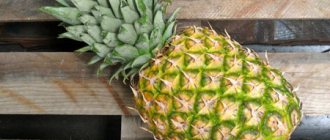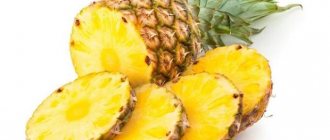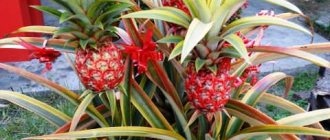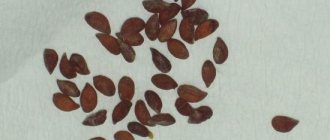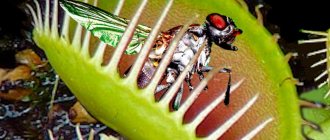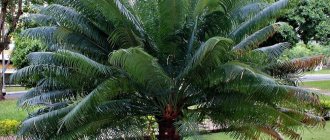Pineapple as a houseplant. The most common species: A. Crested, A. Pritsvetnikovy, A. Variegata, A. Porteanus. Pineapple propagation at home. Transplantation, care.
Pineapple is a genus of 8 species belonging to the Bromeliad family. Habitat: Brazil, Colombia, Paraguay and Venezuela. One species of greatest interest is the Pineapple Large-tufted. This is the only representative of the bromeliad family, the fruits of which are eaten by people. Pineapple is a valuable fruit crop and is cultivated all over the world; it is its fruits that lie on the shelves of our stores.
Pineapple plantation
General description and varieties
The literal translation of the word “pineapple” is the smell of odors. The plant is aptly named. Scientists are still arguing – is pineapple a fruit or a vegetable?
Pineapple is a herbaceous plant. Its prickly leaves are collected in a rosette, in nature they reach a height of 1 meter and are capable of storing moisture. Pineapple flowers are collected in a beautiful compact inflorescence.
In indoor floriculture, pineapples are grown for their beautiful leaves, which, with good care, can reach 70 cm. Flowering in an apartment occurs very rarely. Let's look at the most interesting types of pineapple for indoor floriculture:
1. Crested pineapple - edible, already mentioned above.
Pineapple Crested
2. Pineapple Bract - much more decorative, it has bronze-green leaves with a yellow border.
Pineapple bract with fruit and children
3. Pineapple Variegata has green and cream stripes on the leaves that turn pink in good light.
Pineapple Variegata
4. Pineapple Porteanus - the leaves have yellowish-cream stripes, red along the edges.
More about the flower
Growing a homemade pineapple
In the center of the herbaceous plant there grows a stem, in the middle of which there is a tip - an inflorescence. After fertilization, it becomes infertility. Its individual particles grow together, that is, they form a pineapple. A rosette, which is thick and fleshy leaves, surrounds the stem.
Pineapple fruits are cylindrical and oval in shape, formed by numerous individual small parts that grow together. The leaves form a rosette at the top. The scaly, dense shell of a ripened fruit acquires a reddish, yellow, dark green, brown color with bright yellow pulp inside.
Transfer
Perhaps the biggest difficulty in caring for a pineapple is replanting. It is produced as needed, if the plant is clearly cramped in an old pot and only by transshipment. Pineapples don't like to be disturbed.
If you cannot do without a transplant, do it as carefully as possible. Take a wide shallow pot (pineapple has a shallow root system), pour fine expanded clay on the bottom, and a 3 cm thick layer of soil on top. You must remove the plant from the old pot very carefully, trying not to collapse the earthen ball. Place the pineapple in a new container and cover it with fresh soil so that there is no difference between the level of fresh soil and the top layer of soil of the overloaded plant. Carefully press the new soil with your fingers and add 2-3 cm.
Planting a pineapple
Flower care
For homemade pineapple, no special conditions are required. In order for the crop to grow and develop safely, it is necessary to take care of the correct temperature, watering, and lighting. An exotic plant grown in a pot can not only bloom, but also bear fruit.
Interesting articles about indoor plants.
Lighting
Homemade pineapple, as in nature, prefers to grow in a well-lit place. It is best to place a pot with a tropical crop on the south side. The recommended length of daylight should be between eight and ten hours. If the flowerpot is placed on western or eastern windows, lighting is required throughout the year. In winter and autumn, additional lighting is required. It is organized using fluorescent lamps.
Temperature
The culture must be kept warm. The temperature in the room where pineapple is kept at home should not fall below +16 degrees throughout the year. In such conditions, the plant does not die, but it does not grow well either. The optimal temperature for the normal life cycle is considered to be between 22 and 25 degrees Celsius. This is true for any season.
The soil must not be allowed to freeze. In the fall, until the central heating is turned on, a pot of pineapple should not be kept on the windowsill, which can be cold at this time of year. It is necessary to keep indoor pineapple exclusively warm and remove it from cold windows when the need arises.
A pineapple
Humidity
In winter, the pineapple indoor plant should not be kept near heating devices or heaters. Drafts are also contraindicated for this culture. In summer, it is sprayed abundantly and often. Water is sprayed around. Some experienced gardeners recommend pouring liquid inside the socket, but this is quite dangerous. Stagnation of moisture inside the outlet can lead to the development of rot. Leaves cannot be sprayed. It is recommended to wipe the crown with a damp cloth.
Watering
In summer, decorative home pineapple requires abundant and active watering. The next moistening of the soil is carried out only after the top layer of soil has dried. The water must be settled (keep for at least a day) and have a temperature ranging from 30 to 35 degrees Celsius.
The frequency of watering is reduced from the last week of autumn until the end of winter. In the cool season, caring for indoor pineapple involves reducing the amount of moisture introduced. And if in summer a tropical crop is watered once a week, on cool days the amount is reduced by two or three times.
Priming
An indoor pineapple flower requires a loose soil mixture with an acidity between 4.0 and 5.0 pH. It should allow moisture to pass through well. The soil is prepared from the following components:
- coarse sand;
- chopped peat;
- humus;
- turf land.
The ingredients are taken in ratios 1:3:2:3. It is recommended to take a low and wide pot, since the root system should be located close to the top soil layer.
Circumcision
Tropical pineapple in indoor conditions, as in nature, forms independently. The grower will not need to prune to give the crop the desired shape. The main thing is to promptly remove damaged and dried leaves. Healthy ones should not be touched. To avoid damaging the green leaves, it is recommended to use pointed garden shears. You must act as carefully as possible.
Top dressing
At the beginning of the growing season, fertilize the tropical crop twice a month. You can add cow humus, but it is much easier to control the concentration of fertilizing if you use a mineral complex. However, when studying the question of how to care for pineapple in a pot, you should take into account that the drugs are diluted twice as weakly as indicated in the instructions.
Tropical crops are sprayed monthly with a solution of iron sulfate with a concentration of 0.01%. Root fertilizers are introduced once every two weeks. In autumn and winter, the plant does not require fertilizers. Alkaline fertilizers, as well as wood ash and lime, are contraindicated for decorative pineapple.
Pineapple for growing at home
Transfer
An ornamental pineapple plant in a pot requires replanting only in the first and second year of life. It is not recommended to frequently disturb adult specimens. This is due to the fact that the root system of the crop is poorly developed and quite fragile. Transplantation is carried out using the transshipment method.
You should not take a flowerpot that is too large. For an adult plant, a pot with a volume of 3-4 liters is suitable. If you take a container that is too large, water will begin to stagnate in the space that is not filled with moisture.
Reproduction
For an indoor pineapple, caring for it at home is not difficult, and even a novice gardener can create conditions for successful growth of the crop. The tropical plant reproduces through daughter shoots, which are necessarily formed if properly maintained, after fruiting.
Each pineapple is capable of producing up to five daughter shoots. They are separated from the main part using a sharp knife. Each such shoot, the height of which should be from 15 to 20 cm, should have its own well-developed root system.
Flowering indoor pineapple
They are planted in pots that are not too voluminous. Such flowerpots do not allow the root system to grow too much. The trunk with roots is buried one centimeter deep. The pot is placed in a warm place and moistened regularly. Rooting takes from two to four weeks.
You can use the tops of ripe fruits in a similar way. This part of the pineapple is called the “sultan”. It is carefully cut out. It is not recommended to plant the sultan directly into the substrate. The top is left to dry out a little, and only then planted in the ground for rooting.
You can also try the seed method at home if the crop bears fruit successfully:
- Pollination is carried out using a brush. When the process is successful, the seeds are removed from the ripe fruit, soaked in potassium permanganate and dried.
- The seed material is placed in a light nutrient mixture. Moderate watering is carried out. The seeds are buried 2 centimeters and covered with polyethylene or glass.
It will not be possible to achieve rapid seed germination. This process can take up to several months. Plantings should be kept at optimal temperature and humidity.
Pests and diseases
Pineapples are rarely damaged by diseases and pests, but they do occur.
False scale insect - any infected plant was brought into the house. The pest moves very slowly and was most likely transferred to the pineapple by humans or animals through direct contact. In the initial stage, you can remove the false scale insect with a cotton swab soaked in alcohol. Treat the pineapple with a solution of karbofos or a weak solution of potassium manganese. If there are a lot of pests, the plant will have to be thrown away - it is completely impossible to get them out of the leaf axils, and repeated spraying with karbofos will not bring anything good to either the pineapple or your family.
Fungal infection - most likely the pineapple was watered into an outlet. This cannot be done. If the disease is in its early stages, try treating the pineapple with a fungicide. If the core rots, the plant cannot be saved.
Possible problems
1. The tips of the pineapple leaves dry out - dry air. Spray the plant, increase the humidity.
2. Mold on a pineapple pot or on the soil - excessive watering in winter. Give the plant less moisture. Gently wipe off the mold from the pineapple pot with a clean cloth.
3. Root rotting - excess moisture at low temperatures. Cut off and root the top of the pineapple.
4. Slow growth - cold water and air, or lack of nitrogen. Feed the pineapple, heat the water for irrigation, increase the room temperature.
Pineapple propagation
Reproduction of pineapple by apical rosette
Propagation of pineapple in itself is a fascinating business. It occurs either by planting an apical rosette, cut off along with part of the fruit, or by children growing after fruiting. The first method of pineapple propagation is easier, the second is reliable.
So, we propagate pineapple with an apical rosette. Most often we use store-bought fruit. The problem is that the top of a fresh pineapple will take root well. You can't be sure of either one. Select a pineapple with fresh, firm leaves and no damage or rot. By the way, the top of an unripe pineapple takes root better.
Carefully cut off the top of the selected fruit. Sprinkle the cut area with crushed activated carbon tablets to prevent the pineapple from rotting. Leave for 4-7 days for calus to form in a dark place. Then take a shallow wide pot and fill it with the same soil as for replanting a pineapple. Press the prepared top into the substrate 3 cm. Cover with a jar or other transparent container to maintain moisture. If everything goes well, the pineapple will root after one and a half to two months.
To propagate by children, wait until the pineapple sprouts reach a size of 15-20 cm, carefully break them out and plant them in small pots. High humidity must be maintained. For successful rooting of pineapple, both apical cuttings and children, it is necessary to maintain a temperature of 25-30 degrees.
How to properly plant a pineapple from the top and care for it after planting?
So, after the planting material has been prepared, you can begin planting the plant itself. At this stage, it is necessary to pay attention to the soil in which we will plant the plant. Suitable for our purposes:
- Self-prepared soil, which can be obtained by mixing sand, peat and ordinary soil in equal proportions
- And also soil for cacti purchased in a special store.
- And one more thing, in addition to the earth, we will need expanded clay
As for the capacity, to begin with it will be enough to take a small pot, which will have a volume of about 1 liter.
- We take a container and pour expanded clay onto its bottom. Its layer should be large enough, since this material will serve as a drainage system.
- Next, fill the container with the selected soil.
- It is recommended to pre-moisten the soil, but do not make the pot completely muddy.
- Now make a hole in the ground; its depth should be such that the top trunk can easily fit into it.
- Carefully place the “tuft” in the hole, fill the hole with earth, and lightly tamp it down. It is permissible to sprinkle the lower leaves a little with soil, but the rest should not be immersed in the ground.
- Check that the top is firmly anchored in the ground and does not fall. Water the plant a little.
Growing Pineapple
- After carrying out all the above manipulations, it is necessary to “hide” the plant in a bag. In this way, the conditions necessary for its rooting will be created. Remove the bag from the pineapple regularly to ventilate it. You can completely remove the bag when the fruit has taken root.
- Now choose a permanent place for the planted fruit. The room in which the pineapple will grow must be warm, without drafts. At the same time, you cannot place the container with the plant in a place where it will be exposed to direct sunlight, near radiators, heaters, stoves, etc. Pineapple is contraindicated in cold, drafts, dry air and constant exposure to the sun.
- Also water your pineapple regularly , using only warm water. As for its quantity, it all depends on the requirements of the plant. As soon as the top soil becomes dry, water the fruit generously. Do not forget, it is important to moisten the soil not only on the surface of the pot, but also below.
- You can periodically feed the plant with fertilizers, this will also have a beneficial effect on its growth and development. You can buy them at any flower shop.
- Next, keep an eye on the plant; after about a couple of months you will see that the leaves of the “tuft” disappear, and new ones appear in their place. This is a good sign and will indicate that the plant has taken root and is actively growing. Carefully remove dry leaves so that they do not interfere with the growth of new ones.
- After about 1-1.5 years, transplant the plant into a larger container. This can be done at almost any time, with the exception of the flowering period. You need to replant a pineapple without shaking off the soil from its roots.
Flowering and fruiting
Pineapple flower
Know that if you grow a pineapple in an apartment, most likely you will not see any flowering or fruiting of your pet. Enjoy the beautiful leaves and proudly tell your guests that this pretty bromeliad plant is a pineapple. True, anything can happen. Perhaps you will be lucky. And if the pineapple has already bloomed, most likely, fruits will also form.
Flowering lasts up to 2 weeks. It can occur either in May-July or in December. Sometimes it is recommended to place apples next to it to stimulate pineapple flowering. The fruit ripens in about 4 months.
Pineapple will probably bloom and bear fruit only in a greenhouse or conservatory.
